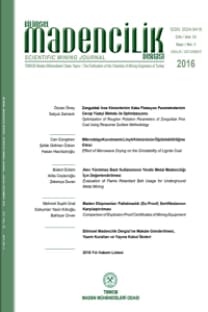Predicting screening/classification products via the pseudorandom number selection routine
Eleme, Sınıflandırma, Yalancı rastgele sayı üretme, Tane seçimi, Algoritma
PREDICTING SCREENING AND CLASSIFICATION PRODUCTS VIA THE PSEUDORANDOM NUMBER SELECTION ROUTINE
___
Austin, L. G., Klimpel, R. R., and Luckie, P. T. (1984). Process Engineering of Size Reduction: Ball Milling (Vol. 1). New York: AIME. Camalan, M. (2021a).A computational algorithm to understand the evolution of size distribution with successive breakage events at grinding (In Press). Proceedings of the 2nd International Electronic Conference on Mineral Science. https://doi.org/10.3390/iecms2021-09381
Camalan, M. (2021b). Investigating the effects of random sieving losses on particle size distributions. Particulate Science and Technology, 39(1), 108–115. https://doi.org/10.1080/02726351.2019.1669749
Coelho, M. A. Z., and Medronho, R. A. (1992). An Evaluation of the Plitt and Lynch & Rao Models for the Hydrocyclones. In L. Svarovsky and T. M. Thew (Eds.), Hydrocyclones Analysis and Applications (pp. 63–72). Springer.
Davoodi, A., Asbjörnsson, G., Hulthén, E., and Evertsson, M. (2019). Application of the discrete element method to study the effects of stream characteristics on screening performance. Minerals, 9(12). https://doi.org/10.3390/min9120788
Dong, K. J., Wang, B., and Yu, A. B. (2013). Modeling of particle flow and sieving behavior on a vibrating screen: From discrete particle simulation to process performance prediction. Industrial and Engineering Chemistry Research, 52(33), 11333–11343. https://doi.org/10.1021/ie3034637
Dong, K. J., and Yu, a. B. (2012). Numerical simulation of the particle flow and sieving behaviour on sieve bend/low head screen combination. Minerals Engineering, 31, 2–9. https://doi.org/10.1016/j.mineng.2011.10.020
Dündar, H. (2020). Investigating the benefits of replacing hydrocyclones with high-frequency fine screens in closed grinding circuit by simulation. Minerals Engineering, 148(January), 106212. https://doi.org/10.1016/j.mineng.2020.106212
Elskamp, F., and Kruggel-Emden, H. (2015). Review and benchmarking of process models for batch screening based on discrete element simulations. Advanced Powder Technology, 26(3), 679–697. https://doi.org/10.1016/j.apt.2014.11.001
Frausto, J. J., Ballantyne, G. R., Runge, K., Powell, M. S., Wightman, E. M., Evans, C. L., … Gomez, S. (2021). The effect of screen versus cyclone classification on the mineral liberation properties of a polymetallic ore. Minerals Engineering, 169(April), 106930. https://doi.org/10.1016/j.mineng.2021.106930
Gupta, A., and Yan, D. (2016). Mineral Processing Design and Operations. Amsterdam: Elsevier. Heiskanen, K. G. H. (1996). Developments in wet classifiers. International Journal of Mineral Processing, 44–45(SPEC. ISS.), 29–42. https://doi.org/10.1016/0301-7516(95)00015-1
Hogg, R. (2008). Issues in particle size analysis. KONA Powder and Particle Journal, 26(March), 81–93. https://doi.org/10.14356/kona.2008009
Kelly, E. G. (1991). The significance of by-pass in mineral separators. Minerals Engineering, 4(1), 1–7. https://doi.org/10.1016/0892-6875(91)90113-A
Khoshdast, H., Shojaei, V., and Khoshdast, H. (2017). Combined application of computational fluid dynamics (CFD) and design of experiments (DOE) to hydrodynamic simulation of a coal classifier. International Journal of Mining and Geo-Engineering, 51(1), 9–22. https://doi.org/10.22059/ijmge.2016.218483.594634
King, R. P. (2012). Modeling and Simulation of Mineral Processing Systems (C. L. Schneider and E. A. King, eds.). SME. Kruggel-Emden, H., and Elskamp, F. (2014). Modeling of screening processes with the discrete element method involving non-spherical particles. Chemical Engineering and Technology, 37(5), 847–856. https://doi.org/10.1002/ceat.201300649
Mangadoddy, N., Vakamalla, T. R., Kumar, M., and Mainza, A. (2020). Computational modelling of particle-fluid dynamics in comminution and classification: a review. Mineral Processing and Extractive Metallurgy: Transactions of the Institute of Mining and Metallurgy, 129(2), 145–156. https://doi.org/10.1080/25726641.2019.1708657
Matsumoto, M., and Nishimura, T. (1998). Mersenne Twister: A 623-Dimensionally Equidistributed Uniform Pseudo-Random Number Generator. ACM Transactions on Modeling and Computer Simulation, 8(1), 3–30. https://doi.org/10.1145/272991.272995
Merkus, H. G. (2009). Particle Size Measurements: Fundamentals, Practice, Quality. New York: Springer.
Mular, A. L. (2009). Size Separation. In M. C. Fuerstenau and K. Han (Eds.), Principles of Mineral Processing (pp. 119–172). SME.
Muñoz, D. A., Diaz, J. L., Taborda, S., and Alvarez, H. (2017). Hydrocyclone Phenomenological-Based Model and Feasible Operation Region. International Journal of Mining, Materials, and Metallurgical Engineering, 3, 1–9.
Nageswararao, K., Wiseman, D. M., and Napier-Munn, T. J. (2004). Two empirical hydrocyclone models revisited. Minerals Engineering, 17(5), 671–687. https://doi.org/10.1016/j.mineng.2004.01.017
Napier-Munn, T. J., and Lynch, A. J. (1992). The modelling and computer simulation of mineral treatment processes - current status and future trends. Minerals Engineering, 5(2), 143–167. https://doi.org/10.1016/0892-6875(92)90039-C
Narasimha, M., Brennan, M., and Holtham, P. N. (2007). A Review of CFD Modelling for Performance Predictions of Hydrocyclone. Engineering Applications of Computational Fluid Mechanics, 1(2), 109–125. https://doi.org/10.1080/19942060.2007.11015186
Svarovsky, L., and Svarovsky, J. (1992). A New Method of Testing Hydrocyclone Grade Efficiencies. In L. Svarovsky and T. M. Thew (Eds.), Hydrocyclones Analysis and Applications (pp. 68–70). Springer.
Tang, Z., Yu, L., Wang, F., Li, N., Chang, L., and Cui, N. (2018). Effect of particle size and shape on separation in a hydrocyclone. Water (Switzerland), 11(1), 1–19. https://doi.org/10.3390/w11010016
Wills, B. A., and Finch, J. A. (2016). Wills’ Mineral Processing Technology. Amsterdam: Elsevier.
Wong, C. K., and Easton, M. C. (1980). An Efficient Method for Weighted Sampling without Replacement. SIAM Journal on Computing, 9(1), 111–113. https://doi.org/10.1137/0209009
Zhao, L., Zhao, Y., Bao, C., Hou, Q., and Yu, A. (2016). Laboratory-scale validation of a DEM model of screening processes with circular vibration. Powder Technology, 303, 269–277. https://doi.org/10.1016/j.powtec.2016.09.034
- ISSN: 2564-7024
- Yayın Aralığı: 4
- Yayıncı: TMMOB Maden Mühendisleri Odası
Tamer SÖZBİR, Mustafa ÇİÇEKLER
Quantifying the effect of the grinding aids in a batch stirred mill by a modelling approach
Eleme ve sınıflandırma ürünlerinin sözde rastgele sayı üretme rutiniyle tahmini
Yicong ZENG, Hailiang XU, Bo WU
Predicting screening/classification products via the pseudorandom number selection routine
Modifiye kalsitin dolgu tutunumu ve fluting kağıtların mekanik özellikleri üzerine etkileri
Kalsitik ve dolomitik kireçtaşlarının çimentolu macun dolgunun çevresel davranışına etkisi
